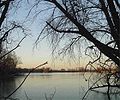
Frederick William was Elector of Brandenburg and Duke of Prussia, thus ruler of Brandenburg-Prussia, from 1640 until his death in 1688. A member of the House of Hohenzollern, he is popularly known as "the Great Elector" because of his military and political achievements. Frederick William was a staunch pillar of the Calvinist faith, associated with the rising commercial class. He saw the importance of trade and promoted it vigorously. His shrewd domestic reforms gave Prussia a strong position in the post-Westphalian political order of Northern-Central Europe, setting Prussia up for elevation from duchy to kingdom, achieved under his son and successor.
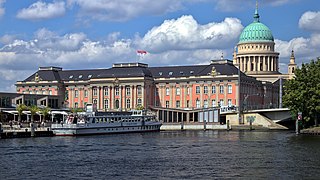
Potsdam is the capital and, with around 183,000 inhabitants, largest city of the German state of Brandenburg. It is part of the Berlin/Brandenburg Metropolitan Region. Potsdam sits on the River Havel, a tributary of the Elbe, downstream of Berlin, and lies embedded in a hilly morainic landscape dotted with many lakes, around 20 of which are located within Potsdam's city limits. It lies some 25 kilometres southwest of Berlin's city centre. The name of the city and of many of its boroughs are of Slavic origin.

The Havel is a river in northeastern Germany, flowing through the states of Mecklenburg-Vorpommern, Brandenburg, Berlin and Saxony-Anhalt. It is a right tributary of the Elbe and 325 kilometres (202 mi) long. However, the direct distance from its source to its mouth is only 94 kilometres (58 mi). For much of its length, the Havel is navigable; it provides an important link in the waterway connections between the east and west of Germany, as well as beyond.

Wannsee is a locality in the southwestern Berlin borough of Steglitz-Zehlendorf, Germany. It is the westernmost locality of Berlin. In the quarter there are two lakes, the larger Großer Wannsee and the Kleiner Wannsee, located on the River Havel and separated only by the Wannsee Bridge. The larger of the two lakes covers an area of 2.7 km2 (1.0 sq mi) and has a maximum depth of 9 m (30 ft).
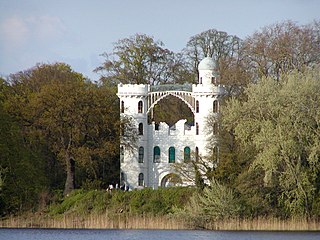
Pfaueninsel is an island in the River Havel situated in Berlin-Wannsee, in the district of Steglitz-Zehlendorf in southwestern Berlin, near the border with Potsdam in Brandenburg. The island is part of the Palaces and Parks of Potsdam and Berlin UNESCO World Heritage Site because of its outstanding Prussian architecture, and is a popular destination for day-trippers. Pfaueninsel is also a nature reserve in accordance with the EU Habitats Directive and a Special Protection Area for wild birds.

The Protestant Church of the Redeemer is located to the south of the village of Sacrow, which since 1939 has been incorporated to Potsdam, the capital of the German Bundesland of Brandenburg. It is famous for its Italian Romanesque Revival architecture with a separate campanile and for its scenic location. It was built in 1844. The design was based on drawings by King Frederick William IV of Prussia, called the Romantic on the Throne. The building was realized by Ludwig Persius, the king's favorite architect. In 1992, the church along with the park and Sacrow Manor was added by UNESCO to the World Heritage Site "Palaces and Parks of Potsdam and Berlin" for its architecture and cohesion with the surrounding park.
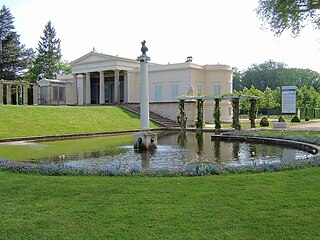
Charlottenhof Palace or Charlottenhof Manor is a former royal palace located southwest of Sanssouci Palace in Sanssouci Park at Potsdam, Germany. It is best known as the summer residence of Crown Prince Frederick William. Today it is maintained by the Prussian Palaces and Gardens Foundation Berlin-Brandenburg.

Friedrich Wilhelm Freiherr von Erdmannsdorff was a German architect and architectural theoretician, and one of the most significant representatives of early German Neoclassicism during the Age of Enlightenment. His work included Wörlitz Palace in the present-day Dessau-Wörlitz Garden Realm, one of the earliest Palladian buildings on the European continent. His most well-known student was Friedrich Gilly, the teacher of Karl Friedrich Schinkel.

The Province of Brandenburg was a province of Prussia from 1815 to 1945. Brandenburg was established in 1815 from the Kingdom of Prussia's core territory, comprised the bulk of the historic Margraviate of Brandenburg and the Lower Lusatia region, and became part of the German Empire in 1871. From 1918, Brandenburg was a province of the Free State of Prussia until Prussia was dissolved in 1945 after World War II, and replaced with reduced territory as the State of Brandenburg in East Germany, which was later dissolved in 1952. Following the reunification of Germany in 1990, Brandenburg was re-established as a federal state of Germany, becoming one of the new states.

Sanssouci is a historical building in Potsdam, near Berlin. Built by Prussian King Frederick the Great as his summer palace, it is often counted among the German rivals of Versailles. While Sanssouci is in the more intimate Rococo style and is far smaller than its French Baroque counterpart, it, too, is notable for the numerous temples and follies in the surrounding park. The palace was designed and built by Georg Wenzeslaus von Knobelsdorff between 1745 and 1747 to meet Frederick's need for a private residence where he could escape the pomp and ceremony of the royal court. The palace's name is a French phrase that translates as "without concerns", meaning "without worries" or "carefree", emphasising that the palace was meant as a place of relaxation, rather than a seat of power.

Babelsberg is the largest quarter of Potsdam, the capital city of the German state of Brandenburg. The neighbourhood is named after a small hill on the Havel river. It is the location of Babelsberg Palace and Park, part of the Palaces and Parks of Potsdam and Berlin UNESCO World Heritage Site, as well as Babelsberg Studio, a historical centre of the German film industry and the first large-scale movie studio in the world.

The Margraviate of Brandenburg was a major principality of the Holy Roman Empire from 1157 to 1806 that played a pivotal role in the history of Germany and Central Europe.

Schwielowsee is a municipality in the Potsdam-Mittelmark district, in Brandenburg, Germany. It is situated on the shore of the Schwielowsee lake, through which the River Havel flows. The municipality was founded on December 31, 2002 in merger of the three villages Caputh, Geltow and Ferch. The Caputh Ferry, a cable ferry across the Havel, links Caputh and Geltow. In the east Schwielowsee shares border with the City of Potsdam, in the west with the town of Werder (Havel).

David Gilly was a German architect and architecture-tutor in Prussia, known as the father of the architect Friedrich Gilly.

The Marmorpalais is a former royal residence in Potsdam, near Berlin in Germany, built on the grounds of the extensive Neuer Garten on the shores of the Heiliger See. The palace was commissioned by King Frederick William II of Prussia and designed in the early Neoclassical style by the architects Carl von Gontard and Carl Gotthard Langhans. The palace remained in use by the Hohenzollern family until the early 20th century. It served as a military museum under communist rule, but has since been restored and is once again open to the public.

The Havel Canal, or Havelkanal in German, is a canal in the German state of Brandenburg. It provides an alternate route to the River Havel, between Hennigsdorf and Paretz, thus avoiding a passage through the waterways of Berlin between Spandau and Potsdam.

The Sacrow–Paretz Canal, or Sacrow-Paretzer-Kanal in German, is a canal in the northeastern German state of Brandenburg. It provides a short cut for vessels navigating the River Havel, linking the Jungfernsee, near Potsdam, with Paretz.

Babelsberg Park is a 114 hectare park in the northeast of the city of Potsdam, bordering on the Tiefen See lake on the River Havel. The park was first designed by the landscape artist Peter Joseph Lenné and, after him, by Prince Hermann von Pückler-Muskau and Karl Friedrich Schinkel, by order of the then-prince William I and his wife, Augusta. Located on a hill sloping down to the lake, the park and castle are part of the Palaces and Parks of Potsdam and Berlin, which were inscribed on the UNESCO World Heritage List because of their unique architecture and testimony to the development of landscape design.
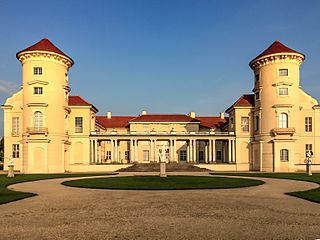
Rheinsberg Palace lies in the municipality of Rheinsberg, about 100 kilometres (62 mi) northwest of Berlin in the German district of Ostprignitz-Ruppin.

Park Glienicke, is an English landscape garden in the southwestern outskirts of Berlin, Germany. It is located in the locality of Wannsee in the Steglitz-Zehlendorf borough. Close to Glienicke Bridge the park is open to the general public. The park is part of the UNESCO World Heritage Site Palaces and Parks of Potsdam and Berlin. Within the ensemble it is one of the five main parks, the others being Sanssouci Park, New Garden, Babelsberg Park and Peacock Island (Pfaueninsel). Regarding diversity in gardening styles within the Potsdam park ensemble Park Glienicke is only superseded by Sanssouci Park. Furthermore, it is a park especially characterized by one personality due to the intense involvement of Prince Charles of Prussia. The park covers approximately 116 hectares





